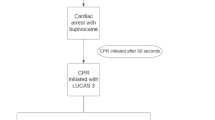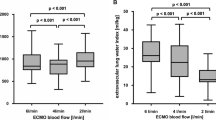Abstract
In order to asses the influence of continuous haemofiltration (HF) on haemodynamics and central blood volume in endotoxic shock, endotoxinaemia was invoked in 20 swine (28–32 kg). 15 min after doubling the mean pulmonary pressure, the animals were randomly assigned to receive either a zero-balanced veno-venous HF with an ultrafiltration and replacement rate of 600 ml/h (HF group,n=10) or to observe the spontaneous course (E group,n=10) under a constant infusion of endotoxin for 4h. A trend to a higher survival rate in the HF group (6/10 vs. 3/10; group) during the observation period was evident, but not statistically significant. Early initiation of HF during endotoxic shock modifies the haemodynamic response, lowering the pulmonary artery pressure (PAP), PCWP, pulmonary (PVR) and systemic vascular resistance (SVR), compared to the spontaneous course, whereas the decrement of central blood volume was comparable in both groups. These changes cannot be explained by effects of the HF on the volume status, but supports and additional effect by the filtration of small and medium-sized molecules.
Similar content being viewed by others
References
Mauritz W, Sporn P, Schindler I, Zadrobilek E, Roth E, Appel W (1986) Akutes Nierenversagen bei abdomineller Sepsis — Vergleich von Hämodialyse und kontinuierlicher arteriovenöser Hämofiltration. Anästh Intensivther Notfallmed 21:212–217
Simpson K, Allison M (1988) Acute renal failure — continuous ultrafiltration and bicarbonate haemodialysis (CUPID). Intensive Care World 5:83–84
Schetz M, Lauwers PM, Ferdinande P (1989) Extracorporeal treatment of acute renal failure in the intensive care unit: a critical view. Intensive Care Med 15:349–357
Wendon J, Smithies M, Sheppard M, Bullen K, Tinker J, Bihari D (1989) Continuous high volume venous-venous haemofiltration in acute renal failure. Intensive Care Med 15:358–363
Gotloib L, Barzilay E, Shustak A, Wais Z, Jaichenko J, Lev A (1986) Hemofiltration in septic ARDS. The artifical kidney as an artificial endocrine lung. Resuscitation 13:123–132
Staubach KH, Rau HG, Kooistra A, Schardey HM, Hohlbach G, Schildberg FW (1988) Can Hemofiltration increase survival time in acute endotoxinemia — a porcine shock model. Abstract: 2nd Vienna Shock, Forum, May 11–14, 1988, Vienna, Austria, p 69
Borg T, Alvfors A, Gerdin B, Modig J (1985) A porcine model of early adult respiratory distress syndrome induced by endotoxinaemia. Acta Anaesthesiol Scand 29:814–830
Kreimeier U, Gerspach S, Veitinger K, Neuhof H, Meßmer K (1988) Hyperdyname Endotoxinämie — Mikrozirkulationsstörung und Eicosanoide. In: Schriefers KH (ed) Chirurgisches Forum 88 für experimentelle und klinische Forschung. Springer, Berlin Heidelberg New York, pp 291–295
Lava JS, Rice CL, Levine HA, Moss GS (1982) Extravascular lung water as a function of the magnitude of pulmonary artery pressure in the septic pig. J Surg Res 32:440–447
Modig J (1987) Positive effects of Ketamine versus Metomidate anesthesia on cardiovascular function, oxygen delivery and survival. Acta Chir Scand 153:7–13
Modig J (1988) Comparison of effects of dextran-70 and Ringers acetate on pulmonary function, hemodynamics and survival in experimental septic shock. Crit Care Med 16:266–271
Ball HA, Cook JA, Wise WC, Halushka PV (1986) Role of thromboxane, prostaglandins and leukotrienes in endotoxic and septic shock. Intensive Care Med 12:116–126
Pfeiffer UJ (1987) Das intrathorakale Blutvolumen als Leitparameter zur Blutvolumenregulation in der Intensivmedizin. Habilitationsschrift, Technische Universität München, 1987
Stein B, Maucher H, Wiedeck H, Born B, Ahnefeld FW (1989) Die Steuerung der Ultrafiltrationsrate als Hauptkomponente eines neuen Bilanzierungssystems während kontinuierlicher Hämofiltration. Anaesthesist 38:536–538
Wardle N (1982) Acute Renal Failure in the 1980's: the Importance of Septic Shock and of Endotoxinaemia. Nephron 30:193–200
Houtchens BA, Westenkow DR (1984) Oxygen consumption in septic shock. Circ Shock 13:361–384
Groeneveld ABJ, Nauta JJP, Thijs LG (1988) Peripheral vascular resistance in septic shock: its relation to outcome. Intensive Care Med 14:141
Bond RF (1985) Peripheral circulatory responses to endotoxin. In: Proctor RA (ed) Handbook of endotoxin, vol 2. Pathophysiology of endotoxin. Elsevier, Amsterdam New York, pp 36–75
Magilligan DJ (1985) Effects of ultrafiltration on lung water. In: Sieberth HG, Mann H (eds) Continuous arteriovenous hemofiltration (CAVH). Karger, Basel München, pp 80–95
Baldamus CA (1986) Hemodynamics in hemofiltration. In: Henderson LW, Quellhorst EA, Baldamus CA, Lysaght MJ (eds) Hemofiltration. Springer, Berlin Heidelberg New York, pp 155–200
Vagge R, Cavatora F, Queirelo C, Rosselli P, Gentile A, Bertulla A (1988) Hemodynamic changes during acetate dialysis, bicarbonate dialysis and hemofiltration. Blood Purif 6:43–50
Coraim F, Pauser G, Stellwag F, Werner T, Ziegler W (1985) Positive Beeinflussung der Hämodynamik bei postkardiochirurgischen Patienten durch die Hämofiltration. Anaesthesist 34:236
McManus LM, Hanahan DJ, Demopoulos CA, Pinckard RN (1980) Pathobiology of the intravenous infusion of acetyl glyceryl ether phosphorylcholine (AGEPC), a synthetic platelet-activating factor (PAF), in the rabbit. J Immunol 124:2919–2921
Beutler B, Cerami A (1987) Cachectin: more than a tumor necrosis factor. N Engl J Med 316:379–385
Parillo JE, Burch C, Shelhamer JH, Parker MM, Natanson C, Schuette W (1985) A circulating myocardial depressant substance in humans with septic shock. J Clin Invest 76:1539–1553
Kühl PG, Bolds JM, Loyd J, Snapper JR, Fitzgerald GA (1988) Thromboxane receptor-mediated bronchial and haemodynamic responses in ovine endotoxinemia. Am J Physiol 254:R310–319
Parillo JE (1985) Cardiovascular dysfunction in septic shock: new insights into a deadly disease. Int J Cardiol 7:314–316
Author information
Authors and Affiliations
Rights and permissions
About this article
Cite this article
Stein, B., Pfenninger, E., Grünert, A. et al. Influence of continuous haemofiltration on haemodynamics and central blood volume in experimental endotoxic shock. Intensive Care Med 16, 494–499 (1990). https://doi.org/10.1007/BF01709399
Received:
Accepted:
Issue Date:
DOI: https://doi.org/10.1007/BF01709399




